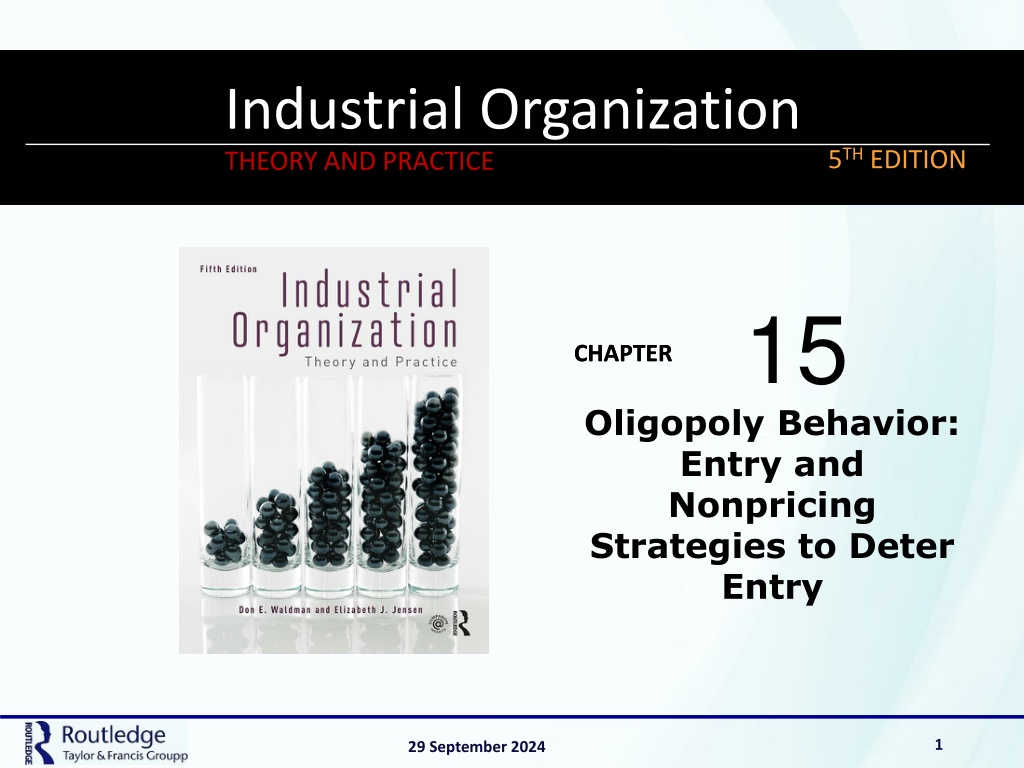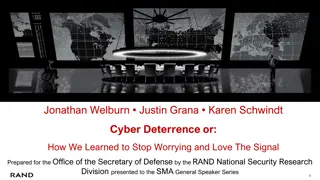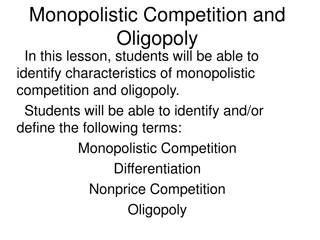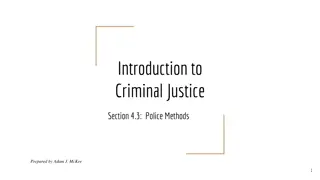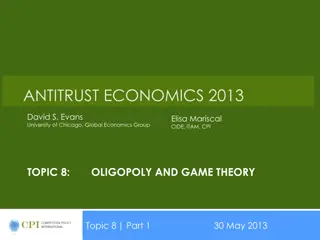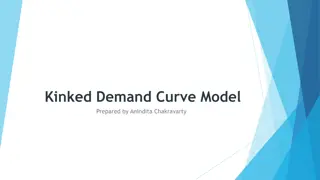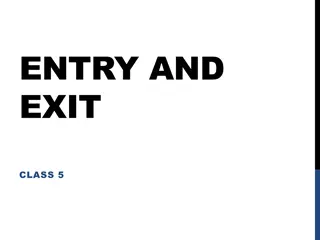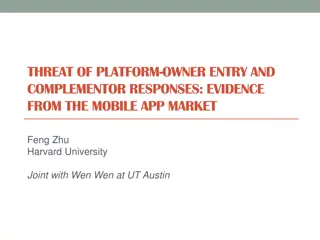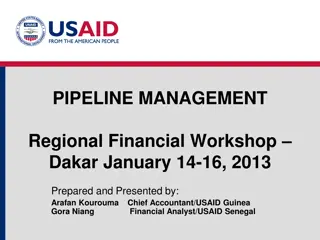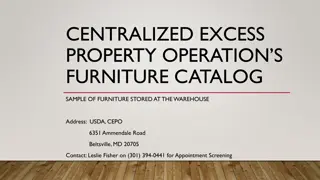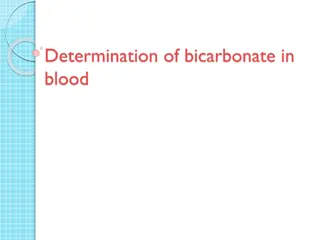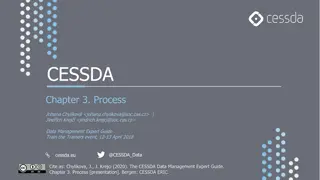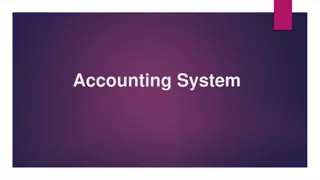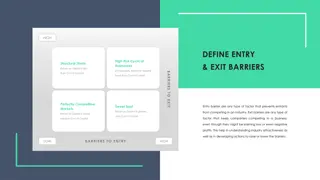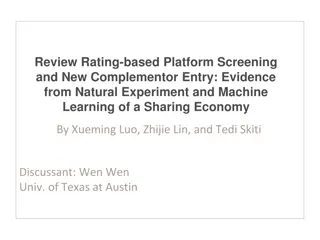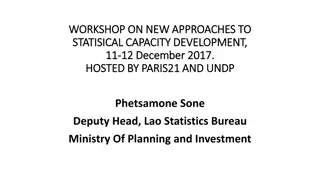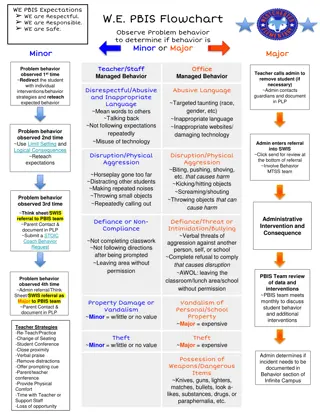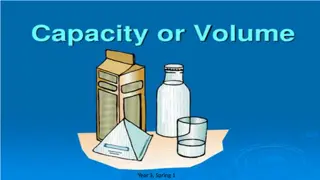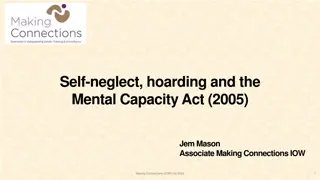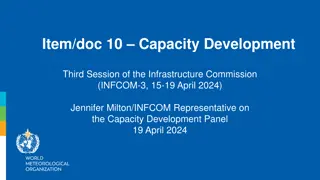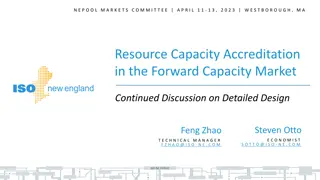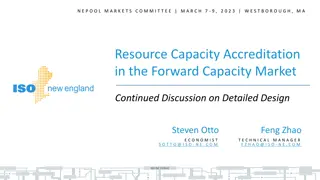Oligopoly Behavior: Excess Capacity Models and Entry Deterrence Strategies
Examine the concept of excess capacity models in oligopoly behavior, where a monopolist may strategically deter entry by either building excess capacity or expanding current production facilities in response to potential entrants. Explore scenarios involving sunk costs, marginal costs, pricing strategies, and profit maximization in a dynamic market setting.
Download Presentation

Please find below an Image/Link to download the presentation.
The content on the website is provided AS IS for your information and personal use only. It may not be sold, licensed, or shared on other websites without obtaining consent from the author. Download presentation by click this link. If you encounter any issues during the download, it is possible that the publisher has removed the file from their server.
E N D
Presentation Transcript
MODERN LABOR ECONOMICS THEORY AND PUBLIC POLICY THEORY AND PRACTICE Industrial Organization 12THEDITION 5THEDITION 15 CHAPTER CHAPTER Oligopoly Behavior: Entry and Nonpricing Strategies to Deter Entry 1 29 September 2024
15.1 Excess Capacity Models of entry deterrence based on the building of excess capacity are models in which the monopolist moves first and selects a level of capacity, then the potential entrant decides whether to enter, then the monopolist selects a capacity level and an output. The potential entrant produces a quantity of zero if it stays out. Panel (a) shows a monopolist that faces a market demand p=100-q and currently can produce up to 40 units of output at a constant marginal cost of $20, with fixed costs of zero. Because the monopolist can produce only 40 units, the marginal cost of producing more than 40 units is infinite, so the MC curve is vertical at 40. Absent the threat of entry, the monopolist maximizes profit by producing 40, setting price = $60 and earning profit of $1600. 29 September 2024 2
15.1 Excess Capacity Now suppose that a potential entrant appears. For a sunk cost of $575, the potential entrant can build a plant capable of producing output at a constant marginal cost of $20 up to a maximum capacity of 20 units. Assume that if the potential entrant builds the plant and enters, it produces at capacity and sells 20 units. Therefore, if entry occurs, the monopolist faces the residual demand curve p=80-q in panel (b). Given this residual demand curve, the monopolist maximizes profit by producing 30 and charging $50. To simplify the analysis, we assume a zero discount rate so that a dollar of profit in period 1 equals a dollar of profit in period 2. Profits for the two firms are: ??= ? ? ??1 ???= 30 50 20 0 = 900 0 = $900 ???= ? ? ???? ????= 30 50 20 575 = 600 575 = $25 29 September 2024 3
15.1 Excess Capacity Alternatively, in response to entry, the monopolist can increase its capacity by expanding its current production facilities. Suppose that for a sunk cost of $575, the monopolist can expand its plant so that it can produce up to a maximum of 60 units at a lower marginal cost of $15 per unit. Panel (c) shows the monopolist s new marginal cost curve, ??2. If the monopolist builds this additional capacity in response to entry, it faces the residual demand curve p=80-q, produces 32.5 units and charges $47.50. Total quantity demanded at this price is 52.5, so ??= ? ? ??2 ???= 32.5 47.5 15 575 = $481.25 ???= ? ? ???? ????= 20 47.5 20 575 = $25 If the potential entrant elects not to enter, and the monopolist builds the extra capacity (panel (d)), it faces the market demand curve, and so will produce 47.5 units at a price of $52.5 and earn profit of ??= ? ? ??2 ???= 47.5 52.5 15 575 = $1231.25 29 September 2024 4
15.1 Excess Capacity Representing this as a game theory problem, the monopolist moves first and selects a level of capacity. The entrant then decides to enter or stay out. If the monopolist selects a large capacity, the game moves to node ??1, so the entrant stays out and the monopolist earns a profit of $1231.25. If the monopolist selects a small capacity, the game moves to node ??2, so entrant enters, the monopolist maintains a small capacity at node ?4, and the entrant earns a profit of $25, while the monopolist earns a profit of $900. In the Nash equilibrium, the monopolist selects a large capacity and the potential entrant stays out. 29 September 2024 5
15.1 Excess Capacity 15.1.1 Investing in Research and Development to Lower Costs One alternative to investment in excess capacity would be in investment in research and development. A monopolist might have a choice of either investing or not investing in cost- reducing R&D in period 1. Suppose in the absence of any threat of entry, the monopolist is better off not investing in R&D. Faced with a threat of entry, however, if the monopolist chooses not to invest in R&D in period 1, it earns a large profit in period 1, but entry will occur, reducing period 2 profits. Alternatively, faced with a threat of entry, the monopolist can invest in R&D in period 1 and earn a smaller profit in period 1, but if the monopolist s lower costs in period 2 deter entry, the monopolist s profits will be significantly increased in period 2. This might play out exactly like the previous game, with the monopolist investing in R&D and the potential entrant to staying out. Even if entry is not deterred in period 2, the investment in R&D, by lowering the monopolist s costs relative to the potential entrant s costs, might increase the monopolist s combined profits in the two periods. 29 September 2024 6
15.1 Excess Capacity 15.1.2 Empirical Evidence Aluminum In its landmark 1945 Alcoa antitrust decision, a majority of the Second Circuit Court of Appeals ruled that Alcoa had built excess capacity to deter entry into the aluminum refining industry. Titanium Dioxide Hall has suggested that Du Pont built excess capacity in the titanium dioxide industry to deter entry. Titanium dioxide is a chemical whitener used to make products such as paint or paper either whiter or opaque. In the 1960s three different processes were used to manufacture titanium dioxide. The first two, the sulfate process and the generic chloride process, were available to all titanium dioxide producers. The third process, however, was the proprietary chloride process developed exclusively by Du Pont. Because Du Pont s chloride process had low pollution control costs relative to the other two processes, Du Pont s costs were unaffected by tougher pollution control laws instituted in the 1970s, and Du Pont s technology was the industry s low-cost technology. Hall tested whether Du Pont s pattern of capital expansion between 1972 and 1979 was consistent with an entry deterrence policy. As Table 15.1 on the next slide indicates, Du Pont committed capital to preempt its five smaller rivals. 29 September 2024 7
15.1 Excess Capacity 15.1.2 Empirical Evidence 29 September 2024 8
15.1 Excess Capacity 15.1.2 Empirical Evidence Container Shipping Lines Two separate studies have suggested that international freight container shipping lines have used excess capacity to deter entry. Fusillo theorized that the shipping market was structured perfectly for the use of excess capacity to deter entry and that the dominant firms responded to the threat of fringe entry by developing excess capacity. According to Fusillo, the dominant firms supplied more and larger ships on lines threatened by fringe entry; therefore, an increase in the fringes share resulted in an increase in incumbents excess capacity. Wu examined three major shipping lines in Taiwan and found that the two deep- sea lines consistently maintained significant levels of excess capacity throughout the period. The smaller regional carrier, however, began the period with a below-optimal level of capacity, but as this smaller line expanded, it too developed excess capacity. As the smaller firm developed excess capacity, the other two firms reduced their excess capacity, so that overall the three maintained a significant level of excess capacity to deter entry. 29 September 2024 9
15.2 Raising Rivals Costs Firms may attempt to deter entry by raising rivals costs of entry. In the predatory pricing game with perfect, complete, certain, and symmetric information, there is no credible way of deterring entry. Now consider a game with slightly different payoffs. The monopolist earns $10 million instead of $7 million if it does not raise costs, and the monopolist has the option of undertaking a strategic action that increases both the potential entrant s costs and its own costs by $4.1 million. If the monopolist does not raise costs, the game moves to node ??1, the potential entrant enters, the monopolist accommodates, and both firms earn profits equal to $4 million. If the monopolist takes a strategic action that raises costs by $4.1 million for both the potential entrant and itself, the games moves to node ??2, the entrant now sustains an economic loss no matter what action the monopolist takes in response to entry and therefore, the potential entrant stays out. Because the potential entrant stays out, the game moves to node ?4 and the monopolist earns an economic profit of $5.9 million, which is 47.5 percent larger than the $4 million profit it earns if it does not raise costs. The Nash equilibrium is for the monopolist to raise costs and the potential entrant to stay out. 29 September 2024 10
15.2 Raising Rivals Costs The monopolist may have even better possible outcomes. It might be able to spend $1.00 to increase the potential entrant s costs by more than $1.00; perhaps, for example, it can spend $1.00 to increase the potential entrant s costs by $2.00, or $5.00, or $100.00. How can a monopolist raise its rivals costs? Economists have suggested four primary methods: 1. lobbying the government to erect barriers to entry, 2. increasing advertising expenditures to force entrants to increase their advertising expenditures, 3. providing complementary goods and services to force entrants to also provide complementary products, and 4. sabotaging corporate competitors. 29 September 2024 11
15.2 Raising Rivals Costs 15.2.1 Lobbying to Increase Barriers to Entry Taxi drivers and companies throughout Europe have lobbied aggressively to prevent competition from Uber and other ride sharing companies. In Denmark, taxi companies successfully lobbied to have meters made mandatory for all ride sharing companies as well as all taxi companies, and as a result of this raising of Uber s costs, Uber pulled out of Denmark in 2014. In Italy, Uber was banned from the country in 2017 after its business practices were found to constitute unfair competition as the result of a case filed by the major Italian taxi associations. In Bulgaria Uber was also accused of unfair trade practices and forced to suspend operations. According to Bulgarian regulators, Uber will only be permitted to reenter the Bulgarian market if it meets all the minimum requirements of being a registered taxi service. The Hungarian government passed legislation saying that Uber drivers breach[ed] regulations other taxi firms must adhere to. A new Hungarian law permits its national communications authority to block internet access to Uber dispatch services. Uber has also faced suspensions in Finland, France, Spain and the Netherlands. On September 22, 2017 Transportation for London (TfL) revoked Uber s license to operate in London. TfL concluded that Uber was not fit and proper to hold a London private hire operator license, although Uber was permitted to remain on London s streets pending its appeal of the ruling. 29 September 2024 12
15.2 Raising Rivals Costs 15.2.2 Increasing Advertising An increase in advertising is probably the most common method used to raise rivals costs. Because increased advertising increases both demand and costs, it can theoretically have either a positive or negative effect on profit. Intuitively, increased advertising creates brand loyalty and makes demand more inelastic. These factors limit the likelihood of a net negative effect of increased advertising on dominant firms profits. If the leading firms in an industry increase their advertising expenditures, this increase can deter potential entrants from entering by forcing them to at least match funds spent on advertising. John Sutton studied the impact of increased advertising expenditures on sunk costs and entry in 12 industries operating in six countries. Concluded that increased advertising expenditures deterred entry by increasing sunk costs in many markets. Leading examples included coffee, ready-to-eat cereals, biscuits, beer, prepared soups, margarine, soft drinks, chocolate candy, and baby foods. 29 September 2024 13
15.2 Raising Rivals Costs 15.2.3 Providing Complementary Goods and Services Few markets have been more inundated with complementary services than the Internet service providers (ISP) market was when the market first developed. First, to entice consumers to sign up for its Internet services, America On-Line (AOL) offered 50 free minutes of Internet access for first-time AOL users. It then provided 100 minutes, then 500, then 700, until in 2002, AOL was offering 1000 free minutes that s almost 42 free days of service to convince consumers to try AOL. By giving away so many free minutes of service, AOL made it difficult for smaller ISPs to enter the market, because the new entrants would also have to offer hundreds of hours of free access. Not surprisingly, ISPs are not the only high-tech market where firms have provided complementary goods and services. Wireless telecommunications firms constantly offer free cellular telephones, free minutes, and free premiums to entice consumers to try their service. Airlines and hotels also offer free travel services through their frequent-flyer and rewards programs. Each of these programs increases the cost of entering the market. 29 September 2024 14
15.2 Raising Rivals Costs 15.2.4 Sabotaging Corporate Competitors Occasionally a competitor resorts to rather extreme methods of raising rivals costs by sabotaging a competitor s products or marketing efforts. Sabotage can range from spreading false rumors and filing nuisance lawsuits all the way up to corporate espionage and vandalism against physical facilities. 15.2.5 Empirical Evidence on Raising Rivals Costs The first-mover advantages associated with advertising have been important, effective methods of maintaining market share in many industries. Canned Soups In the US, Campbell s first entered the soup market in 1869 and adopted a strategy of heavy advertising and low prices. Heinz was a late entrant and, despite heavy advertising, was unable to make a significant dent in Campbell s domination. At one time, Heinz s promotional costs exceeded 33 percent of its sales revenues, yet it could not gain a major market share. In 2017, Campbell s still held a huge 83.5 percent share of the condensed soup market in the United States. 29 September 2024 15
15.2 Raising Rivals Costs 15.2.5 Empirical Evidence on Raising Rivals Costs Canned Soups, continued By comparison, in Great Britain, Heinz entered first and Campbell s second. The scenario played out exactly the same way, only with Heinz the leader. Heinz entered the British market in 1930 with ready-to-eat canned soups, as opposed to Campbell s condensed soups, and used heavy advertising to establish its market dominance. Campbell s entered the market in the 1950s with a full line of condensed soups. Heinz s initial reaction was to offer its own line of premium-priced condensed soups, but Heinz quickly switched to a low-price policy on condensed soups. The low-price strategy apparently led British consumers to view condensed soup as a poor-quality alternative to ready-to-eat soups, and Heinz was able to force Campbell s into the role of a minor player in the British market. In 2012 Heinz still held a dominant 68 percent market share of canned soups in the UK. In the United States Heinz has been relegated to being a producer of private label soup, whereas in Britain, Campbell s was forced into an identical private label status. In the United States Campbell s forced Heinz out of the premium brand market, and in Britain Heinz forced Campbell s out. The advantages of the first mover are striking in this example. 29 September 2024 16
15.2 Raising Rivals Costs 15.2.5 Empirical Evidence on Raising Rivals Costs Soft Drinks Although every few years Pepsi launchs a major advertising campaign aimed at taking away Coke s leadership, eventually Coke always seems to maintain its position. Much of Coke s advantage appears to stem from its first-mover advantage of a century ago. With a distinctive bottle and heavy advertising, Coca-Cola established its early leadership in the first two decades of the 20th century. In 1966, Coke held a 33.4 percent share compared with Pepsi s 20.4 percent. Despite a highly successful advertising campaign built around the Pepsi Generation, Pepsi s market share fell to 19.8 percent in 1972, compared with Coke s 34.7 percent. Pepsi then launched another major advertising campaign based on consumers taking the Pepsi Challenge (a taste test). In 1975, however, Coke continued to maintain a 35.3 percent to 21.2 percent market share lead. In the 1980s Coke feared some slippage in its market dominance and introduced New Coke in 1985. New Coke bombed with consumers but led to the reintroduction of Coca-Cola Classic, which proved to be a great success. Ironically Coke s marketing mistake improved its market position, as it continued to dominate the market with Coca-Cola Classic. In 2014 Coke continued to lead the industry with a 42 percent market share, and Pepsi continued to follow with a 30 percent share. 29 September 2024 17
15.2 Raising Rivals Costs 15.2.5 Empirical Evidence on Raising Rivals Costs Consumer Batteries In 1986 Duracell and Eveready dominated the consumer battery market with a combined 80 percent market share. When Kodak attempted to enter the industry, both incumbents responded with expensive advertising campaigns. Eveready boasted that toys powered with its batteries keep on going and going and going. Duracell relied on powerful athletes to show how tough its batteries were. (Then) big and powerful Kodak tried but was unable to appreciably penetrate the market. Other factors besides advertising were also at work here; for example, shelf space was difficult for Kodak to obtain, and Duracell and Eveready also reduced prices. Internet Browsers Economides has suggested that Microsoft raised its rivals costs in the Internet browser market by requiring computer manufacturers to install Microsoft s Internet browser, Internet Explorer, when they installed Microsoft s Windows95 operating system on a computer. 29 September 2024 18
15.2 Raising Rivals Costs 15.2.5 Empirical Evidence on Raising Rivals Costs Examples of Corporate Sabotage Opera Software v. Microsoft WhenOpera produced its Opera 7 web browser, it charged that Microsoft had purposefully sent Opera a style sheet that caused strange things to happen when an Opera 7 user went to the MSN.com website. British Airways v. Virgin Atlantic Airways In 1992, British Airways published an article in its BA News that accused Virgin Atlantic of making up charges of sabotage against British Airways merely for publicity. Virgin Atlantic sued British Airways for libel and the BA News article opened up a Pandora s box for British Airways. In a 1993 settlement, British Airways admitted to playing a series of dirty tricks on Virgin Atlantic. BA broke into Virgin Atlantic s computers and employees cars and homes, and attempted to gather dirt on Virgin Atlantic s founder and CEO, Richard Branson. British Airways sent agents posing as Virgin Atlantic agents to intercept Virgin Atlantic passengers on their way to their gates at JFK airport in New York and told the Virgin Atlantic passengers that their flights had been canceled because of scheduling problems. The agents then switched the passengers to British Airways flights. British Airways employees also called Virgin Atlantic passengers at home and offered them incentives to switch from Virgin Atlantic to British Airways flights. 29 September 2024 19
15.2 Raising Rivals Costs 15.2.5 Empirical Evidence on Raising Rivals Costs Examples of Corporate Sabotage Facebook v. Google In 2011, concerned that Google s new social network site Social Circle might one day threaten its control of the social network market, Facebook hired the top public relations firm Burson-Marsteller to plant stories in the media alleging that Google s Social Circle was invading users privacy. Facebook ordered Burson-Marsteller to refuse to disclose who they were working for, and that led ultimately to the downfall of Facebook s plot. One blogger approached by Burson-Marsteller was Chris Soghoian. Burson-Marsteller promised Soghoian that if he wrote an anti-Google blog, Burson- Marsteller could get it published in top outlets like The Washington Post, Huffington Post, and Politico. However, when Burson-Marsteller refused to disclose who they were working for, Soghoian published their email exchanges and Facebook s dirty tricks campaign became public. 29 September 2024 20
15.3 Learning by Doing As output increases, certain production processes result in lower costs because experience gained through the actual production process lowers direct labor costs. When learning by doing is important, early entrants into the market may be able to maintain a large market share and increase the present value of their profits by strategically producing significantly larger outputs early on than would be justified by short-run profit-maximizing behavior. By producing large quantities in early periods, the first firms into the market can significantly reduce their future costs. A new firm attempting to enter the market later will face a significant cost disadvantage because it will not yet have moved down its learning curve. In markets characterized by significant learning by doing, entry is likely to be difficult. An illustration of a simple learning curve is: ?? ? = 10 +100 2?? where AC(q) represents the average unit cost of production for a cumulative output of q and is a constant measuring the rate at which unit costs decline with volume, or the speed of learning. If =1.5 and q , the second term on the right-hand side would approach zero, and minimum average costs of 10 would be achieved. On the other extreme, if =1.5 and q=0 then average unit costs would be at the maximum of 110. 29 September 2024 21
15.3 Learning by Doing The figure shows how the average cost curve is related to . The larger the value of the more quickly average costs decline to 10. For intermediate values of early entrants can create a type of absolute cost entry barrier by expanding output beyond the short-run profit-maximizing output. By producing large outputs, the first firm or firms into the market are protected from some, if not all, future potential entrants and will maintain higher long-run average market shares. Models based on the existence of learning by doing have suggested that in markets with a moderate rate of learning, entry ceases with only a few firms Like investments in excess capacity and R&D, learning by doing can be viewed as an investment in cost reduction. The early entrant is willing to invest in large current outputs to reduce its future costs, even if this investment significantly reduces current profits. 29 September 2024 22
15.3 Learning by Doing 15.3.1 Empirical Evidence on Learning by Doing In industries characterized by steep learning curves, early entrants can prevent future entry by moving down the learning curve. In such industries the first- mover advantage can create a permanently concentrated market. Commercial Aircraft The learning curve was first identified in the aircraft industry during World War II when it was discovered that with each 100 percent increase in cumulative output, direct labor costs in hours declined by 20 percent. In the 1930s four manufacturers dominated the market: Boeing, Douglas, Lockheed, and Curtiss-Wright. When Douglas developed the DC-3, it was the best commercial aircraft available and Douglas came to dominate the market. From 1937 through 1941, Douglas held a huge market share that ranged from 85 to 98 percent. During World War II, the commercial aircraft industry effectively ceased to exist as all productive capability was turned toward the military. During the war, the government required cross-licensing of patent designs, and as a result, when the war ended Lockheed, Convair, and Martin had all become viable competitors for Douglas. All jockeyed for leadership during the 1950s. 29 September 2024 23
15.3 Learning by Doing 15.3.1 Empirical Evidence on Learning by Doing Commercial Aircraft, continued During the 50s, there was no one firm that was the market leader, and price competition was intense. In 1958 the industry underwent its next major technological breakthrough when Boeing introduced the 707 and Douglas introduced the DC-8. Competition now centered on which of these firms could expand production and move down its learning curve more quickly. As a result, both firms engaged in aggressive price cutting to obtain sales. Convair, Lockheed, and Martin more or less dropped out of the market, and eventually, Boeing came to dominate the industry as its market share increased from 30.1 percent in 1958 to 91.6 percent in 1964 and 78.5 percent in 1965. At the same time Douglas market share plummeted from 67.0 percent in 1957 to just 6.7 percent in 1964. As Boeing continued to control the market, in 1967, Douglas was forced to merge with McDonnell to form McDonnell-Douglas. Shortly thereafter, aggressive price competition between McDonnell-Douglas and Lockheed in the market for wide-body jets left Lockheed on the verge of financial collapse. The history of competition in the commercial aircraft industry is consistent with the strategic use of the learning curve. Firms needed to produce the next new plane and price it low enough to move down the learning curve, which is still true today. 29 September 2024 24
15.3 Learning by Doing 15.3.1 Empirical Evidence on Learning by Doing Semiconductors New products are priced very close to manufacturing costs to take advantage of the learning curve, and the first firm into a new product line tends to gain a significant cost advantage. In 1976 Motorola executive Robert R. Heikes described the competitive environment as follows: The frightening thing in this business is that if you re not first or a fast second or third you re in trouble. . . . If you come in a year late, you d better have a much improved version or a new process that permits you to make the product more cheaply. One example of the importance of the learning curve in the semiconductor industry is Intel s 1971 introduction of the 1024-bit random access memory (RAM) integrated circuit. The Intel 1024-bit RAM was initially priced at $28.00 per unit; by April 1974 the price had declined to between $3.00 and $4.00 per unit. The learning curve has forced firms to price for market share and to anticipate dramatic cost reductions as output increases. Econometric studies of the importance of learning by doing in the semiconductor industry suggest that doubling cumulative output reduces costs by about 20 to 30 percent. 29 September 2024 25
15.3 Learning by Doing 15.3.1 Empirical Evidence on Learning by Doing Entry Deterrence in Hospital Procedures Dafny examined how hospitals can use the interaction of learning by doing and capacity expansion in specific procedures to deter entry. Looked at electrophysiological (EP) studies, a procedure to identify and correct cardiac arrhythmias. In 1989, setting up an EP studies unit in a hospital was very expensive, with costs ranging from $1.5 to $2.0 million. Consistent with the existence of significant learning by doing, medical researchers have long identified a strong positive correlation between procedure-specific volume and patient outcomes over a large number of procedures, including EP studies. Focused on a year when Medicare announced that it would greatly increase the reimbursements to hospitals for EP studies and theorized that in order to deter entry in response to the higher reimbursement, hospitals would increase their volume of these procedures in the year leading up to the Medicare policy change. The results of every regression specification indicated that incumbent hospitals in markets with one potential entrant increased their EP studies volume more rapidly than any other group of incumbent hospitals. Dafny concluded that the results provided strong evidence of hospital investment in learning by doing and increased capacity for the purpose of deterring entry. 29 September 2024 26
15.4 Learning by Doing Product proliferationrefers to the strategic decision to preempt potential entrants by creating brands to fill every available product niche. Economists theorize that by filling many different niches in the market for goods such as beer or breakfast cereals, incumbents are able to prevent potential entrants from gaining even a small foothold in the industry. The intuition behind the product proliferation model is best understood from the viewpoint of a dominant incumbent such as Kellogg s. The optimal strategy for the dominant firm is to enter a new niche (such as sugar-frosted grape-flavored corn flakes ) just before it is profitable for a potential entrant to enter that niche. Suppose, for example, that a potential entrant into the sugar-frosted grape-flavored corn flakes market knows that if it does not enter this market by time t=10, Kellogg s will maximize its profits by entering at t=10 and thereby freeze the potential entrant out of the market. The potential entrant must therefore try to preempt Kellogg s by entering at some time earlier, say t = 10 . Knowing this, Kellogg s must try to preempt the potential entrant by entering at an even earlier time, perhaps t = 10 2 . Such a game regresses backward to a point at which Kellogg s enters the market just infinitesimally before it is profitable for the entrant to enter at all. This is the only solution to the game. Kellogg s enters before it is profitable for the potential entrant to enter and preempts the potential entrant from the grape-flavored corn flakes market, earning more profits than if it had not created the new product. 29 September 2024 27
15.4 Learning by Doing 15.4.1 Empirical Evidence on the Use of Product Proliferation Ready-to-Eat Cereals The ready-to-eat (RTE) cereal market is the most commonly used example of product proliferation. In this industry, the six leading manufacturers (Kellogg s, General Mills, Post, Quaker, Nabisco, and Ralston) increased the number of brands from 26 in 1950 to 80 in 1973. During that 23-year period, 84 new brands were introduced, but 30 did not survive. The rate of introduction increased somewhat over time, as follows: 29 September 2024 28
15.4 Learning by Doing 15.4.1 Empirical Evidence on the Use of Product Proliferation Ready-to-Eat Cereals, continued The new brands typically took market share away from older, established brands. Corn flakes, which accounted for 33 percent of sales in 1940, accounted for only 10.8 percent in 1972, and only 6.8 percent in 1982. Furthermore, the average market share per RTE cereal brand declined from 4 percent in 1950 to just 1.3 percent in 1972. Between 1950 and 1972, Kellogg s introduced 24 new brands, General Mills introduced 34, and Post introduced 21. Only seven new brands ever achieved market shares exceeding 2 percent. The only attempt by new competitors to enter the RTE cereal market occurred in the early 1970s, when Pet, Pillsbury, and Colgate all entered in the healthy cereals/granola category, with some initial success. Pet s Heartland cereal reached almost a 2 percent market share in 1974. The initial success of the intruders led to a response by the major firms. In 1973 Quaker responded first with the introduction of Quaker 100% Natural Cereal. General Mills followed with Nature Valley and Kellogg s with Country Morning. As a result, Heartland s sales plummeted to just 0.1 percent in 1980, and Pillsbury and Colgate left the market. In the long run only Quaker 100% Natural Cereal has left a lasting mark on the industry. 29 September 2024 29
15.4 Learning by Doing 15.4.1 Empirical Evidence on the Use of Product Proliferation Ready-to-Eat Cereals, continued One complicating factor in the cereal industry is that launching a new cereal brand requires huge advertising expenditures. It is possible, therefore, that Kellogg s was able to maintain its dominant share because of lower advertising expenditures per dollar of sales, which resulted in a first-mover advantage. The table indicates that Kellogg s had consistently lower advertising costs than its two major competitors. 29 September 2024 30
15.4 Learning by Doing 15.4.1 Empirical Evidence on the Use of Product Proliferation Ready-to-Eat Cereals, continued In 1982, Kellogg s continued to lead the industry with a 39 percent share followed by General Mills with 21 percent, Post with 16 percent, and Quaker Oats with 9 percent. One reasonable interpretation of the evidence is that Kellogg s initially relied on a first-mover advantage to establish its dominance in the basic brands such as Corn Flakes and Rice Krispies, and later used a brand proliferation strategy to maintain its dominant position. Product proliferation in the industry has only increased in recent years. In 2018, General Mills produced 13 varieties of Cheerios alone, including: Cheerios, Honey Nut Cheerios, Multigrain Cheerios, Very Berry Cheerios, Apple Cinnamon Cheerios, Frosted Cheerios, Honey Nut Cheerios Medley Crunch, Cheerios + Ancient Grains, Cheerios Protein, Cheerios Protein Cinnamon-Almond, Fruity Cheerios, Chocolate Cheerios, and Chocolate Peanut Butter Cheerios. General Mills produced 46 different varieties of RTE cereal, and Kellogg s produced 65 varieties. Product proliferation is the primary explanation for the continued dominance of the industry by the same small number of firms. 29 September 2024 31
15.4 Learning by Doing 15.4.1 Empirical Evidence on the Use of Product Proliferation Campbell s Canned Soups and Other Products Campbell s established its dominance in the American canned soup market through a policy of heavy advertising. Has also been augmented by a product proliferation strategy, trying to fill not only every national soup niche, but regional niches as well. In Texas and California, for example, Campbell s made a spicier nacho cheese soup than it did anywhere else. In 1987, it marketed a Creole soup in Southern markets and a red-bean soup in some Hispanic markets. Campbell s sold a Duck-Gizzard Soup in China and a Cream of Chili Poblano soup in Mexico. Campbell s created new brands not only in soups but introduced more than 400 new products in the five-year period between 1981 and 1985. In some cases it introduced entirely new product lines, in an attempt to fill a variety of niches at once. Examples included a full line of Prego spaghetti sauces and Simply Home soups in glass jars. 29 September 2024 32
15.4 Learning by Doing 15.4.1 Empirical Evidence on the Use of Product Proliferation Statistical Evidence on Product Proliferation John Connor investigated the use of the strategy in the food products industry. Connor used data in Advertising Age magazine to identify all new brands in the food products industry for the years 1977 and 1978. The sample included 419 new products introduced into 102 product classes. New products and new flavor varieties were included, but new package sizes and designs were excluded. Of the 419 new products, 59 percent were marketed by the top 50 food or tobacco firms and 70 percent came from the top 200 firms. The 10 most active product lines were as follows: 29 September 2024 33
15.4 Learning by Doing 15.4.1 Empirical Evidence on the Use of Product Proliferation Statistical Evidence on Product Proliferation Connor found that the four-firm concentration ratio had positive effect on the number of new products introduced; however, the square of the four-firm concentration ratio had negative effect on the number of new products introduced. The negative effect of the square of the four-firm concentration ratio suggests that for small values of concentration, the relationship between the number of new products and concentration is positive, but for larger values of concentration, the relationship between the number of new products and concentration is negative. A possible interpretation is that when concentration becomes high, either all product niches have already been filled or product proliferation is less necessary to protect the leading firms market shares. Putsis tested for the significance of product proliferation in the food products market by using supermarket scanner price data from 1991 to 1992 for 135 food product categories in 59 geographic markets. Consistent with basic price theory, Putsis found that an increase in the price of private label products or the market share of branded products resulted in a significant increase in the price of branded products, and an increase in the price of branded products or the market share of private label products resulted in a significant increase in the price of private label products. 29 September 2024 34
15.4 Learning by Doing 15.4.1 Empirical Evidence on the Use of Product Proliferation Statistical Evidence on Product Proliferation Putsis tested the impact of increased brand proliferation on the price of branded and private label products using two measures of brand proliferation: the number of brands in a product category and the brand-level Herfindahl Index. Found that the absolute number of brands in a product category had a statistically significant positive effect on the prices of branded and private label food products. Consistent with the theory that increased product proliferation results in greater market power by both reducing the elasticity of demand for each brand and deterring entry, so increased product proliferation is associated with increased prices. Also found that the Herfindahl Index had a statistically significant negative effect on the prices of branded products and a statistically significant positive effect on the prices of private label food products. In a product category with a large HI, one or a couple of brands dominated the market, and in a product category with a small HI, many brands had significant market shares. The HI, therefore, measured the distribution or dispersion of market shares across brands: the higher the HI, the lower the brand dispersion. Putsis interpreted the negative effect of the Herfindahl Index on the prices of branded products as evidence of the existence of economies of scale or economies of scope in those markets, which result in lower prices. Firms considering introducing new brands should consider not only the impact of that brand on the number of brands, but the impact on brand dispersion as well. 29 September 2024 35
15.5 Empirical Evidence on the Use of Price and Nonprice Strategies to Deter Entry Smiley devised a business questionnaire to examine how often the many methods of entry deterrence where used, asking 294 product managers from major corporations about strategy. The most striking finding was that the strategic use of advertising and product proliferation was common in both new and existing product markets. For both new and existing product lines, 78 percent of respondents claimed that advertising was used at least occasionally to deter entry. Limit pricing and excess capacity appeared to be the least used strategies, but even these were used in a substantial number of markets. For example, 36 percent of the new product respondents and 53 percent of existing product respondents reported at least occasional use of limit pricing. 54 percent of new product respondents and 58 percent of existing product respondents reported frequent use of at least one strategy, and 89 percent of new product and 98 percent of existing product respondents reported at least occasional use of some strategy. 29 September 2024 36
15.5 Empirical Evidence on the Use of Price and Nonprice Strategies to Deter Entry Respondents were also asked the following open-ended question, Have you observed any other activities that appear to be designed primarily to prevent or slow entry? In order of frequency of response, respondents noted the following strategies: 1. Sign long-term contracts with customers, middlemen, or wholesalers. 2. Have product specifications or controlling regulations designed so that only your product qualifies. 3. React aggressively when a new entrant is in the promotion stage, especially with wholesalers and retailers, thereby denying them reliable information about their new product s steady-state profitability. 4. Keep products or processes secret as long as possible. 5. Make preemptive purchases of all available raw materials or supplies. 6. Make early sales to critical buyers opinion leaders. 7. Announce the product long before it is ready. A final point with regard to Smiley s study is notable: Modern industrial organization is sometimes criticized because different theoretical models that, appear to be quite similar on the surface yield dramatically different results. The Smiley study provides evidence that in the real world firms use many different methods to deter entry, and at least two of these methods appear to be diametrically opposed: keeping products or processes secret as long as possible, and announcing the product long before it is ready. 29 September 2024 37
